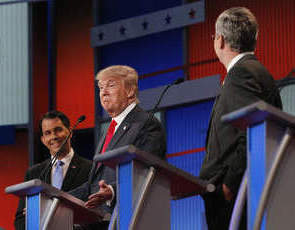
TV game-show host Monty Hall, center, now 94, shown here in the late 1960s on the set of the still-popular “Let’s Make a Deal,” seems suited to have been a role model for CNN’s Anderson Cooper for last week’s first Democratic pres- idential debate of the 2016 election cycle. Cooper acted more like a game- show host than a debate moderator, favoring frontrunners Hillary Clinton and Bernie Sanders while giving short shrift to the other 3 little-known candidates.
TOO MUCH AIR TIME GIVEN
TO THE FRONTRUNNERS,
WHILE SHAFTING WEBB,
O’MALLEY & CHAFEE
Give Trump a barstool or highchair
if he can’t stand 2 hours to debate
IS IT REALISTIC FOR UNIV. OF MD.
TO TRY TO BECOME A BIG-TIME
COLLEGE FOOTBALL POWER?
By David Maril
While wondering if former Gov. Martin O’Malley is nursing a sore arm from patting himself on the back during the first Democratic presidential debate — delivering his long announcement of accomplish- ments “serving” the people of Baltimore and Maryland — it’s interesting to note the following:
![]() CNN deserves low marks for its much ballyhooed presentation of the first Democratic presidential debate.
CNN deserves low marks for its much ballyhooed presentation of the first Democratic presidential debate.
First of all, who determined that Anderson Cooper is an objective, experienced journalist? While CNN kept seasoned and credible newsmen like Jake Tapper and John King pretty much on the sidelines, Cooper moderated the debate with all the tact and professionalism of a game-show host.
Cooper has delivered some very thoughtful and perceptive reports and interviews on CNN and “60 Minutes.” However, he is more a TV essayist and documentarian than a hard-news political reporter.
Much of the broadcast seemed to keep the same glitzy and superficial pace as an episode of “The Price is Right,” making the participants seem more like celebrity panelists competing for a car, yacht or washer/dryer than candidates running for president.
Overall, Cooper allowed too much rhetoric and rambling; but too often suddenly rediscovering his stopwatch at the wrong time, cutting off a candidate when something interesting was being said.
It seemed as if he had been mentored by Monty Hall.
Instead of focusing on helping the national television audience learn more in-depth information about the entire roster of presidential hopefuls, CNN took the easy way out, pandering to the poll numbers and shortchanging the lesser-known candidates.
While Cooper ineffectively tried to instigate confrontations between the two frontrunners, Hillary Clinton and Bernie Sanders, the others were treated as if they were unwanted visitors crashing a neighbor’s birthday party.

Martin O’Malley autographs supporter’s baseball during his last reelection campaign five years ago (in Nov. 2010). The Governor found a way to increase his air time on the first Democratic presidential debate by bait- ing Bernie Sanders and Hillary Clinton. (VoB File Photo/Alan Z. Forman)
Martin O’Malley however found a way to increase his air time by baiting Sanders into an argument about the NRA and gun control issues and challenging Clinton over who was the bigger liberal and more a person of the people.
Jim Webb, however, and Lincoln Chafee could have taken off on a pizza run for half an hour and not been missed. Webb, a former U.S. Senator, decorated military veteran, Secretary of the Navy, journalist and book author, deserved better treatment: He seldom was given a chance to offer his expertise and perspective.
The few times Webb was finally called on, Cooper switched into his militant
time-enforcement mode. And when Webb, continually interrupted by the moderator, objected to not getting his share of speaking time, Cooper kept saying, “You agreed to the terms of the debate.”
One would think those terms must have included fairness and allowing all the candidates to express their points of view.
Even though Chafee, a former mayor, U.S. Senator and Governor of Rhode Island, was the only candidate who made an interesting reference — aimed at former Secretary Clinton — about the importance of having a scandal-free political career, he also was a victim of drawing the moderator’s cold shoulder.
Which raises the question: If you are hosting a debate, why not treat all the participants equally? All of the networks, so far, are letting poll numbers dictate their coverage in the debate approach for both parties.
What would be wrong with determining the candidates’ podium positioning randomly, perhaps by drawing the names out of a hat? While it may be good for the TV cameras to have the two leading candidates in the polls side by side, fairness would dictate a random positioning plan.
The way they were stuck at the ends of the row and left out of the discussion flow, Webb and Chafee may as well have sat in front at a kids’ table with spill-proof lid-covered glasses of milk. The way the whole broadcast played out, they could have been issued toy microphones, with reduced volume, and sent home to bed at 9 p.m.
If the televising networks want more air time to go to the frontrunners, we all would be better served not including the candidates low in the poll ratings. It does everyone a disservice having them on but not treating them with the proper seriousness and respect.

Donald Trump needs a barstool or highchair if he can’t stand for more than two hours to debate his presidential rivals.
![]() On a similar subject, it’s too bad CNBC has apparently caved in to Donald Trump’s demands to limit the debate time for the next GOP clash of candidates to a two-hour time block. The GOP frontrunning blowhard has threatened to boycott the broadcast if his demand isn’t met.
On a similar subject, it’s too bad CNBC has apparently caved in to Donald Trump’s demands to limit the debate time for the next GOP clash of candidates to a two-hour time block. The GOP frontrunning blowhard has threatened to boycott the broadcast if his demand isn’t met.
The network, and the world of politics, would have been better served to let him skip the event, freeing up time for other candidates to get their viewpoints across.
While Trump is a vacuum cleaner for sucking in high TV ratings, he is detrimental to the whole debate format because the networks set him up to dominate the air time.
The thing CNBC should have done was to have offered to give the candidates barstools or highchairs to sit in so they wouldn’t get sore feet standing up for over two hours.
When push comes to shove, Trump would have had a hard time staying away from camera coverage. It would have been interesting to see CNBC stand up to him.
![]() Dr. Ben Carson makes a legitimate point that all the candidates should be allotted the opportunity at the end to make a summation statement.
Dr. Ben Carson makes a legitimate point that all the candidates should be allotted the opportunity at the end to make a summation statement.
He should, however, make this as a request, not a demand.
![]() Only time will tell whether the TV money University of Maryland is gaining from big-time college football makes the overall move to the Big 10 and leaving the ACC worthwhile.
Only time will tell whether the TV money University of Maryland is gaining from big-time college football makes the overall move to the Big 10 and leaving the ACC worthwhile.
One has to question, however, whether it is realistic to ever expect the Terps to develop a competitive major college football program.
The big roadblock is the university’s location. College Park is crammed in the middle between two extremely popular NFL franchises.
Even if the university hires the right big-time coach and commits all the resources needed to develop a major college powerhouse, it will be difficult to compete with the fan worship and loyalty, not to mention money spent, that connect to the Ravens in Baltimore and the Redskins in Washington.
Most Big Ten power franchises are located in areas where they dominate media coverage and fan attention. College Park has too many other things going on around it to cultivate this level of college football fever.
University of Maryland officials have promised to hire a new football coach who will fire up and excite the fan base. But the real question is, just how large is that fan base?
If the team had a 100,000-seat refurbished stadium, would it ever be able to consistently fill it?
davidmaril@voiceofbaltimore.org
“Inside Pitch” is a weekly opinion column written for Voice of Baltimore by David Maril.
CHECK OUT LAST WEEK’S “INSIDE PITCH” COLUMN: click here
…and read archived Dave Maril columns by clicking here.





